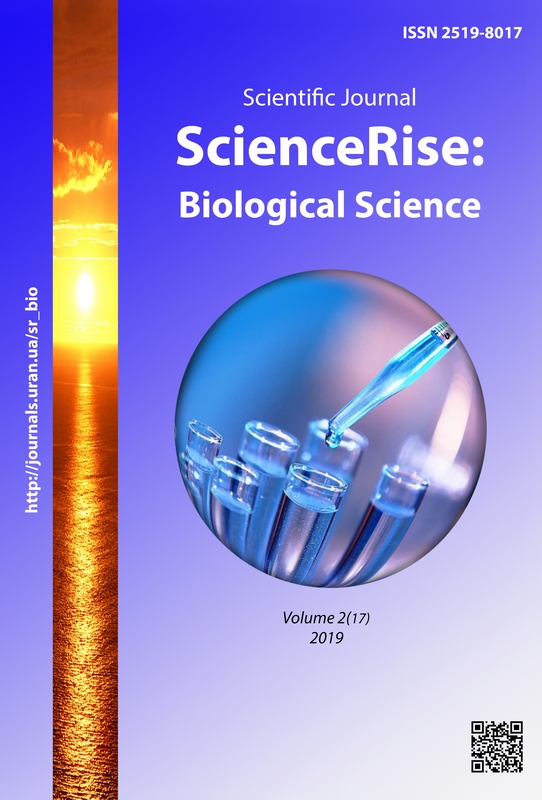Spatial distribution, dimensional-mass and age structure of dab of the gloss Platichthys luscus population of Shabolatsk Liman
DOI:
https://doi.org/10.15587/2519-8025.2019.169657Keywords:
Shabolatsk liman, ichthyocenosis formation, dab gloss, population, fatness, massAbstract
The Shabolatsk liman is situated in the Southern-Western Black Sea side and relates to the type of semi-open, saline-water liman-lagoons.
Since the middle ХХ century essential changes have occurred in the liman hydroecosystem that resulted in the essential transformation of the basin biota.
The aim of the study was in revealing changes in the spatial distribution, dimensional-mass and age structure of the population of dab gloss Platichthys luscus in the Shabolatsk liman.
The composition and population structure of ichthyocenosis of Shabolatsk liman, bio-ecological characteristics of most mass types of fish on the example of dab gloss were studied.
The studies of the spatial distribution of the population of dab gloss Platichthys luscus in the Shabolatsk liman demonstrated that gloss fattens along the whole liman water area, but in the autumn-winter period concentrates in the deep-water saline Southern-Western part of the liman.
The conducted studies of the dimensional-mass and age structure of the Platichthys luscus population in the Shabolatsk liman allowed to establish that the population was presented by five age groups like in the previous period, but the share of fishes of the older age decreased.
Dimensional-mass indices and fatness of dab decreased. It has been established, that the loss of the essential share of the spawning herd in 1992, desalination and worsening of the fodder base resulted in the stable depression of the dab population in liman in the following years.
Taking into account food inclinations of Platichthys luscus (the base of gloss nutrition is mollusks, cancroids and fish (gobies and silversides)), at forming the polyculture in the Shabolatsk liman, dab gloss may be recommended as one of main consumers of zoobenthos that doesn’t come in food competition with other fish typesReferences
- Burhaz, M. I. (2018). Osoblyvosti formuvannia ikhtiotsenozu Shabolatskoho lymanu v umovakh antropohennoi transformatsii vodoimy. Odessa, 20.
- Erdogan, N., Duzgunes, E. Ogut, H.; Briand, F. (Ed.) (2010). Black Sea fisheries and climate change. Climate forcing and its impacts on the Black Sea Marine Biota. No 39 in СIESM Workshop Monographs. Monaco: СIESM, 113–120.
- Shekk, P. V., Kriukova, M. I. (2010). Ocenka kormovoi bazy i perspektivy ispolzovaniia Shabolatskogo limana dlia pastbishchnoi marikultury. Vіsnik zaporіzkogo nacіonalnogo unіversitetu, 1, 1126–1135.
- Çiloğlu, E. (2005). Determination of the Recruitment to Stock and Reproduction Period for Flounder (Platichthys flesus luscus Pallas, 1811) along the Trabzon-Rize Coast, Eastern Black Sea. Turkish Journal of Veterinary and Animal Sciences, 29 (1), 43–48.
- Priakhin, Iu. V., Shnickii, V. A. (2006). Metody rybokhoziaistvennykh issledovanii. Krasnodar: Kubanskii gosuniversitet, 214.
- Kriukova, M. I. (2012). Statystychni metody v biolohichnykh doslidzhenniakh. Odessa: ODEKU, 118.
- Kiriliuk, M. M., Shekk, P. V. (1976). Izuchenie pitaniia ryb CHernogo moria «Biologo-fiziologicheskie osnovy pitaniia morskikh ryb na raznykh stadiiakh razvitiia (kambalovye, kefalevye, bychkovye). Otchet o vypolnenii NIR v 1976 g. No. Gosregistr. 0173.7142571. Odesskoe otdelenie IUgNIRO. Odessa, 59.
- Tarnavskii, M. P. (1960). Kambala-glossa, bychki i drugie ryby v promysle Molochnogo limana. Trudy instituta gidrobiologii An USSR, 35, 213–225.
- Demchenko, V. O. (2004). Ikhtiofauna ta pokaznyky yakosti vody Molochnoho lymanu v zviazku z rybohospodarskym vykorystanniam vodoimy. Kyiv, 24.
- Nazarov, V. M. (1966). Osobennosti rosta, sozrevaniia i plodovitosti chernomorskoi kambaly glossy. Voprosy morskoi biologii. Kyiv: Naukova dumka, 89–91.
- Krotov, A. V. (1941). Rybokhoziaistvennoe ispolzovanie chernomorskikh limanov. Rybnoe khoziaistvo, 7, 87–89.
- Serdiuk, A. V. (1975). Povyshenie effektivnosti rybokhoziaistvennogo ispolzovaniia solenykh limanov severo-zapadnoi chasti Chernogo moria putem akklimatizacii i razvedeniia morskikh i presnovodnykh ryb «Biologicheskie osnovy povysheniia ryboproduktivnosti Tiligulskogo limana. Otchet o vypolnenii NIR v 1975 g. No. Gosregistr. 74060258. Odesskoe otdelenie IUgNIRO. Odessa, 35.
- Kriukova, M. І. (2013). Perspektivy razvitiia marikulturi v Shabolatskom limane v sovremennykh usloviiakh. Ternopіl, 169–172.
- Orlova, L. N. (1977). Povyshenie promyslovoi produktivnosti pribrezhnoi zony severo-zapadnoi chasti Chernogo moria i Prichernomorskikh limanov «Biotekhnika vyrashchivaniia kompleksa prudovykh ryb». Otchet o vypolnenii NIR v 1977 g. No. Gosregistr. 0112.7112331. Odesskoe otdelenie IUgNIRO. Odessa, 61.
- Shekk, P. V., Burgaz, M. І. (2017). Umenshenie organicheskogo zagriazneniia melkovodnykh akvatorii solonovatovodnykh akvatorii pri vyrashchivanii ryb v sadkakh v polikulture. Ribogospodarska nauka Ukraini, 2, 29–39.
Downloads
Published
How to Cite
Issue
Section
License
Copyright (c) 2019 Maryna Burhaz

This work is licensed under a Creative Commons Attribution 4.0 International License.
Our journal abides by the Creative Commons CC BY copyright rights and permissions for open access journals.
Authors, who are published in this journal, agree to the following conditions:
1. The authors reserve the right to authorship of the work and pass the first publication right of this work to the journal under the terms of a Creative Commons CC BY, which allows others to freely distribute the published research with the obligatory reference to the authors of the original work and the first publication of the work in this journal.
2. The authors have the right to conclude separate supplement agreements that relate to non-exclusive work distribution in the form in which it has been published by the journal (for example, to upload the work to the online storage of the journal or publish it as part of a monograph), provided that the reference to the first publication of the work in this journal is included.









